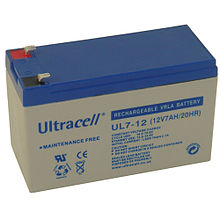Battery Power/Lead Acid Batteries
Lead-acid batteries have a very low energy-to-weight ratio, a low energy-to-volume ratio and the ability to supply high surge currents (i.e: the cells maintain a relatively large power-to-weight ratio). Due to these features and their low cost, they are used in motor vehicles to provide the high current required by automobile starter motors.

History
editLead-acid batteries was invented in 1859 by French physicist Gaston Planté. These batteries are the oldest type of rechargeable battery.
Specifications and Design
edit- Open-circuit (quiescent) at full charge: 12.6 V to 12.8 V (2.10-2.13V per cell)
- Open-circuit at full discharge: 11.8 V to 12.0 V
- Loaded at full discharge: 10.5 V.
- Continuous-preservation (float) charging: 13.4 V for gelled electrolyte; 13.5 V for AGM (absorbed glass mat) and 13.8 V for flooded cells
All voltages are at 20 °C (68 °F), and must be adjusted -0.022V/°C for temperature changes. Float voltage recommendations vary, according to the manufacturer's recommendation. Precise float voltage (±0.05 V) is critical to longevity; insufficient voltage (causes sulfation, explained later) which is almost as detrimental as excessive voltage (causing corrosion and electrolyte loss). After full charge, terminal voltage drops quickly to 13.2 V and then slowly to 12.6 V.
- Typical (daily) charging: 14.2 V to 14.5 V (depending on manufacturer's recommendation)
- Equalization charging (for flooded lead acids): 15 V for no more than 2 hours. Battery temperature must be monitored.
- Gassing threshold: 14.4 V
Equations
editThe lead-acid cell (usually part of a battery) also works on the principal of redox reactions. In its case the anode is a sheet of metallic lead immersed in H2SO4(aq). The lead oxidises according to the following equation:
Pb(s) + SO42-(aq) → PbSO4(s) + 2e-
The cathode is a sheet of lead dioxide, also immersed in H2SO4(aq), which is reduced:
PbO2(s) + 4H+(aq) + SO42-(aq) + 2e- → PbSO4(s) + 2H2O(l)
Thus the H2SO4(aq) is the electrolyte.
Sulfation
editLead-acid batteries lose the ability to hold a charge when discharged for too long due to sulfation, the crystallization of lead sulfate. Sulfation occurs in all lead-acid batteries during normal operation. It clogs the grids, impedes recharging and then expands, cracking the plates and destroying the battery. Sulfation can be avoided if the battery is fully recharged when there is no charge in the battery. The process can often be at least partially prevented or reversed by a desulfation technique called pulse conditioning, in which short but powerful current surges are repeatedly sent through the damaged battery. After some time, this procedure breaks down and dissolves the sulfate crystals, restoring some of the capacity.
Safety Concerns
editLead is extremely toxic. Long-term exposure to even tiny amounts of lead can cause brain and kidney damage, hearing impairment and learning problems in children.
Maintenance
edit- Ammonia can neutralize spilled battery acid.
- Surplus ammonia and water evaporate, leaving an ammonium sulfate residue.
- Sodium bicarbonate (baking soda) is also commonly used for this purpose.